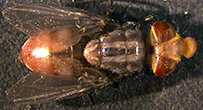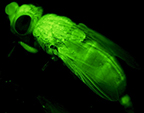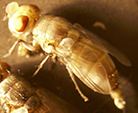 One the major accomplishments of the USDA in the 20th century was the eradication of the New World screwworm fly, C. hominivorax, from all of North and Central America. C. hominivorax females lay their eggs in open wounds or a natural orifice. The hatched larvae then feed on the animal’s living tissue. Animals with severe screwworm infestati
One the major accomplishments of the USDA in the 20th century was the eradication of the New World screwworm fly, C. hominivorax, from all of North and Central America. C. hominivorax females lay their eggs in open wounds or a natural orifice. The hatched larvae then feed on the animal’s living tissue. Animals with severe screwworm infestati ons may die if untreated. C. hominivorax was eradicated using the sterile insect technique, which involved the mass rearing of C. hominivorax, sterilization by irradiation and distribution of sterile flies over the targeted area. Currently, sterile C. hominivorax are released in a “ buffer zone” in southern Panama to prevent re-infestation from South America.
ons may die if untreated. C. hominivorax was eradicated using the sterile insect technique, which involved the mass rearing of C. hominivorax, sterilization by irradiation and distribution of sterile flies over the targeted area. Currently, sterile C. hominivorax are released in a “ buffer zone” in southern Panama to prevent re-infestation from South America.
Transgenic “male-only” C. hominivorax offer the potential of more efficient genetic suppression, reduced diet costs, higher plant capacity, improved monitoring and reduced risk should (in the very unlikely event) any C. hominivorax escape from the plant. Transgenic C. hominivorax lines have been obtained carrying a single-component tetracycline-repressible female-lethal system. Females die at the pupal stage. These strains will be further evaluated for characteristics that influence production such fertility and fecundity. Additional experiments are underway that will provide data needed for a risk-benefit analysis by regulators (e.g. outcrossing potential, longevity). A two-component female-specific embryo lethal genetic system is also being developed at NCSU. The most efficient gene system will be sent to Panama for evaluation in C. hominivorax.

 The Australian sheep blowfly, L. cuprina, is a major pest of sheep in Australia and New Zealand. We are using L. cuprina as a model blowfly to evaluate genetic systems for C. hominivorax and other blowflies that are pests of livestock. We have made several tetracycline-repressible female lethal strains of L. cuprina. The same genetic system was subsequently shown to be effective in C. hominivorax. The strains we have developed could potentially be used for a genetic control program in Australia or New Zealand
The Australian sheep blowfly, L. cuprina, is a major pest of sheep in Australia and New Zealand. We are using L. cuprina as a model blowfly to evaluate genetic systems for C. hominivorax and other blowflies that are pests of livestock. We have made several tetracycline-repressible female lethal strains of L. cuprina. The same genetic system was subsequently shown to be effective in C. hominivorax. The strains we have developed could potentially be used for a genetic control program in Australia or New Zealand
Collaborators
 The male-only C. hominivorax project is in collaboration with Dr. Carolina Concha (COPEG) and Dr. Steven Skoda and his team at the USDA-ARS Screwworm Research Unit in Pacora, Panama. Carolina was until very recently a postdoctoral fellow in the Scott lab and previously when the lab was at Massey University in New Zealand. She has developed several transgenic male-only strains of C. hominivorax, which are currently being evaluated for various important fitness parameters.
The male-only C. hominivorax project is in collaboration with Dr. Carolina Concha (COPEG) and Dr. Steven Skoda and his team at the USDA-ARS Screwworm Research Unit in Pacora, Panama. Carolina was until very recently a postdoctoral fellow in the Scott lab and previously when the lab was at Massey University in New Zealand. She has developed several transgenic male-only strains of C. hominivorax, which are currently being evaluated for various important fitness parameters.
